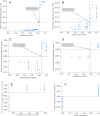What factors enhance students' achievement? A machine learning and interpretable methods approach
- PMID: 40378114
- PMCID: PMC12083833
- DOI: 10.1371/journal.pone.0323345
What factors enhance students' achievement? A machine learning and interpretable methods approach
Abstract
Prior research on student achievement has typically examined isolated factors or bivariate correlations, failing to capture the complex interplay between learning behaviors, pedagogical environments, and instructional design. This study addresses these limitations by employing an ensemble of five machine learning algorithms (SVM, DT, ANN, RF, and XGBoost) to model multivariate relationships between four behavioral and six instructional predictors, using final exam performance as our outcome variable. Through interpretable AI techniques, we identify several key patterns: (1) Machine learning with explainability methods effectively reveals nuanced factor-achievement relationships; (2) Behavioral metrics (hw_score, ans_score, discus_score, attend_score) show consistent positive associations; (3) High-achievers demonstrate both superior collaborative skills and preference for technology-enhanced environments; (4) Gamification frequency (s&v_num) significantly boosts outcomes; while (5) Assignment frequency (hw_num) exhibits counterproductive effects. The results advocate for: (a) teachers should balance direct instruction with active learning modalities to optimize achievement, and (b) early warning systems should leverage identifiable learning features to proactively support struggling students. Our framework enables educators to transform predictive analytics into actionable pedagogical improvements.
Copyright: © 2025 Mao et al. This is an open access article distributed under the terms of the Creative Commons Attribution License, which permits unrestricted use, distribution, and reproduction in any medium, provided the original author and source are credited.
Conflict of interest statement
The authors have declared that no competing interests exist.
Figures







Similar articles
-
Predicting academic achievement from the collaborative influences of executive function, physical fitness, and demographic factors among primary school students in China: ensemble learning methods.BMC Public Health. 2024 Jan 23;24(1):274. doi: 10.1186/s12889-024-17769-7. BMC Public Health. 2024. PMID: 38263081 Free PMC article.
-
Academic achievement prediction in higher education through interpretable modeling.PLoS One. 2024 Sep 5;19(9):e0309838. doi: 10.1371/journal.pone.0309838. eCollection 2024. PLoS One. 2024. PMID: 39236050 Free PMC article.
-
Assessment and Evaluation of Different Machine Learning Algorithms for Predicting Student Performance.Comput Intell Neurosci. 2022 May 9;2022:4151487. doi: 10.1155/2022/4151487. eCollection 2022. Comput Intell Neurosci. 2022. PMID: 35586111 Free PMC article.
-
Validating instructional design and predicting student performance in histology education: Using machine learning via virtual microscopy.Anat Sci Educ. 2024 Jul-Aug;17(5):984-997. doi: 10.1002/ase.2346. Epub 2023 Oct 7. Anat Sci Educ. 2024. PMID: 37803970
-
Perceived teacher support and student engagement among higher education students - a systematic literature review.BMC Psychol. 2025 Feb 11;13(1):112. doi: 10.1186/s40359-025-02412-w. BMC Psychol. 2025. PMID: 39934874 Free PMC article.
References
-
- Celik I, Dindar M, Muukkonen H, Järvelä S. The Promises and Challenges of Artificial Intelligence for Teachers: a Systematic Review of Research. TechTrends. 2022;66(4):616–30. doi: 10.1007/s11528-022-00715-y - DOI
-
- Freeman L, Batarseh FA, Kuhn DR, Raunak MS, Kacker RN. The Path to a Consensus on Artificial Intelligence Assurance. Computer. 2022;55(3):82–6. doi: 10.1109/mc.2021.3129027 - DOI
-
- Järvelä S, Malmberg J, Haataja E, Sobocinski M, Kirschner PA. What multimodal data can tell us about the students’ regulation of their learning process? Learning and Instruction. 2021;72:101203. doi: 10.1016/j.learninstruc.2019.04.004 - DOI
-
- Ober TM, Cheng Y, Carter MF, Liu C. Leveraging performance and feedback‐seeking indicators from a digital learning platform for early prediction of students’ learning outcomes. Computer Assisted Learning. 2023;40(1):219–40. doi: 10.1111/jcal.12870 - DOI
-
- Yu H, Guo Y. Generative artificial intelligence empowers educational reform: current status, issues, and prospects. Front Educ. 2023;8. doi: 10.3389/feduc.2023.1183162 - DOI
MeSH terms
LinkOut - more resources
Full Text Sources

